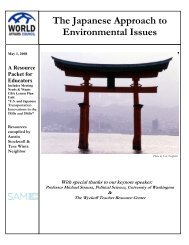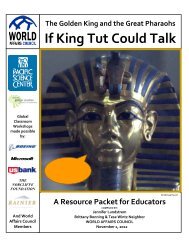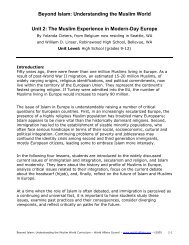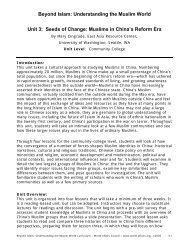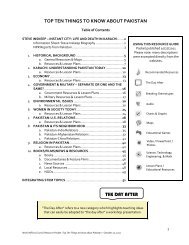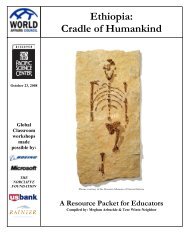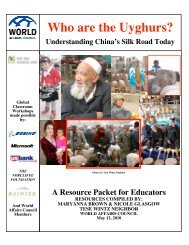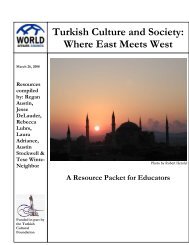turkey on our minds and in our classrooms - World Affairs Council
turkey on our minds and in our classrooms - World Affairs Council
turkey on our minds and in our classrooms - World Affairs Council
Create successful ePaper yourself
Turn your PDF publications into a flip-book with our unique Google optimized e-Paper software.
HISTORY AND CULTURE<br />
Video: Ebru Marbel<strong>in</strong>g<br />
http://www.metacafe.com/watch/452851/art_<strong>on</strong>_the_water_art_of_marbl<strong>in</strong>g_ebru_sanati_birlikde_ay<br />
rili/<br />
A video representati<strong>on</strong> of traditi<strong>on</strong>al Ebru marbl<strong>in</strong>g is used to create art with n<strong>on</strong>-traditi<strong>on</strong>al subjects,<br />
such as people.<br />
Islamic Art: Early Ottoman Art<br />
http://www.discoverislamicart.org/exhibiti<strong>on</strong>s/ISL/the_ottomans/?lng=en<br />
From humble orig<strong>in</strong>s as a small emirate <strong>in</strong> Northwest Anatolia, the Ottomans rose to become <strong>on</strong>e of<br />
the greatest Islamic empires <strong>in</strong> history…Although its roots were <strong>in</strong> Anatolia, <strong>and</strong> it drew <strong>in</strong>spirati<strong>on</strong><br />
from s<strong>our</strong>ces as disparate as the cultures the empire had subsumed, the art of the Ottomans was <strong>in</strong> a<br />
very large part devised <strong>in</strong> <strong>and</strong> dissem<strong>in</strong>ated from the imperial-c<strong>our</strong>t workshops <strong>in</strong> Istanbul.<br />
New York Times Modern Women Artists <strong>in</strong> Turkey Meet Their Trailblaz<strong>in</strong>g Counterparts<br />
(12/14/2011)<br />
http://www.nytimes.com/2011/12/15/world/europe/modern-women-artists-<strong>in</strong>-<str<strong>on</strong>g>turkey</str<strong>on</strong>g>-meet-theirtrailblaz<strong>in</strong>g-counterparts.html?_r=1&scp=9&sq=36%20h<strong>our</strong>s%20<strong>in</strong>%20istanbul&st=cse<br />
“Dream <strong>and</strong> Reality”, a show at the Istanbul Modern art museum, pairs “nearly forgotten” pa<strong>in</strong>ters<br />
from the Ottoman era with some of the most <strong>in</strong>trigu<strong>in</strong>g artists <strong>in</strong> Turkey today. The comm<strong>on</strong> thread?<br />
All are women.<br />
Arabic Calligraphy<br />
http://www.islamicart.com/ma<strong>in</strong>/calligraphy/<strong>in</strong>dex.html<br />
While many religi<strong>on</strong>s have made use of figural images to c<strong>on</strong>vey their core c<strong>on</strong>victi<strong>on</strong>s, Islam has<br />
<strong>in</strong>stead used the shapes <strong>and</strong> sizes of words or letters. In Islamic <strong>and</strong> Arabic cultures, calligraphy became<br />
a highly respected art—the art of writ<strong>in</strong>g.<br />
LITERATURE<br />
Turkish Literature<br />
http://www.turkishculture.org/pages.php?ChildID=715&ParentID=3&ID=4&ChildID1=473&miMore=1#P<br />
ageC<strong>on</strong>tent<br />
The history of Turkish Literature may be divided <strong>in</strong>to three periods, reflect<strong>in</strong>g the history of Turkish<br />
civilizati<strong>on</strong> as follows: the period up to the adopti<strong>on</strong> of Islam, the Islamic period, <strong>and</strong> the period under<br />
Western <strong>in</strong>fluence.<br />
Author Spotlight: Orhan Pamuk<br />
http://www.orhanpamuk.net/<br />
Orhan Pamuk is a noted novelist born <strong>in</strong> Istanbul <strong>in</strong> 1952 who recently w<strong>on</strong> the Nobel Prize <strong>in</strong><br />
Literature. His novel My Name is Red, has been translated <strong>in</strong>to twenty-f<strong>our</strong> languages <strong>and</strong> w<strong>on</strong><br />
<strong>in</strong>ternati<strong>on</strong>al literature’s most lucrative prize (exclud<strong>in</strong>g the Nobel), the IMPAC Dubl<strong>in</strong> Award, <strong>in</strong> 2003.<br />
My Turkish Library (12/18, 2008)<br />
http://www.nybooks.com/articles/22182<br />
In this New York Review of Books article, Nobel-prize w<strong>in</strong>ner Orhan Pamuk reflects <strong>on</strong> his library of<br />
books <strong>and</strong> what various authors <strong>and</strong> their writ<strong>in</strong>gs mean to him.<br />
<strong>World</strong> <strong>Affairs</strong> <strong>Council</strong> Res<strong>our</strong>ce Packet: What the Rest of the <strong>World</strong> can Learn from Turkey Today – March 20, 2012 36



